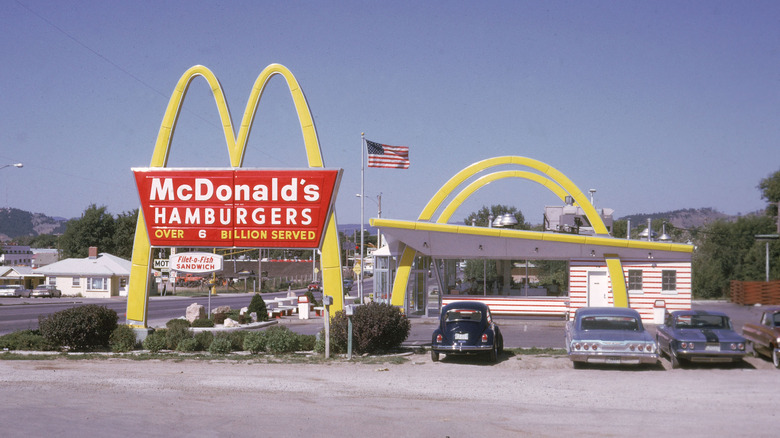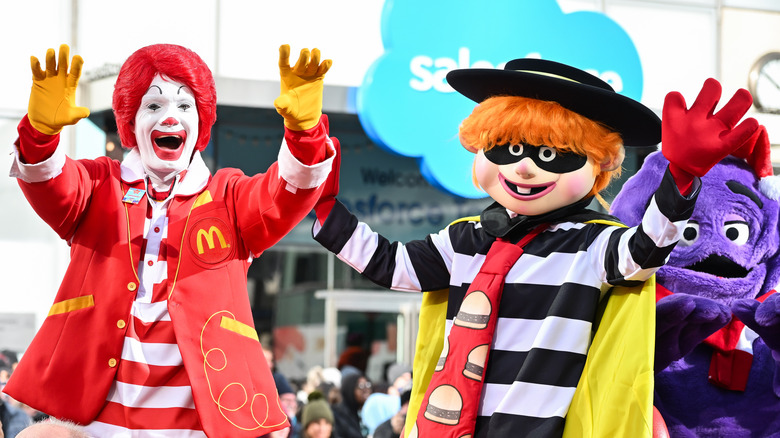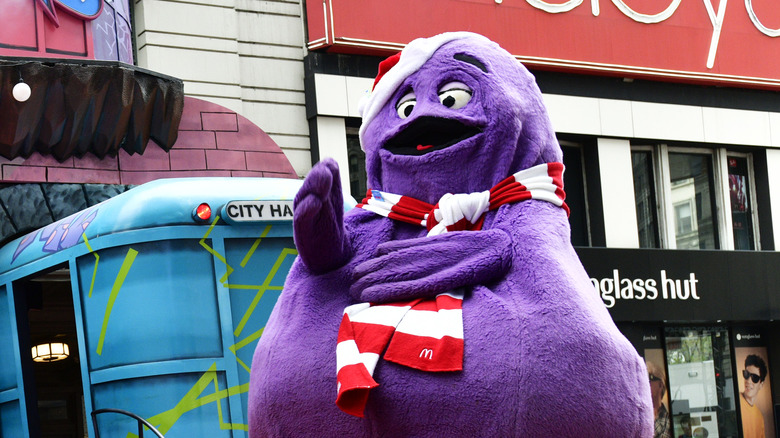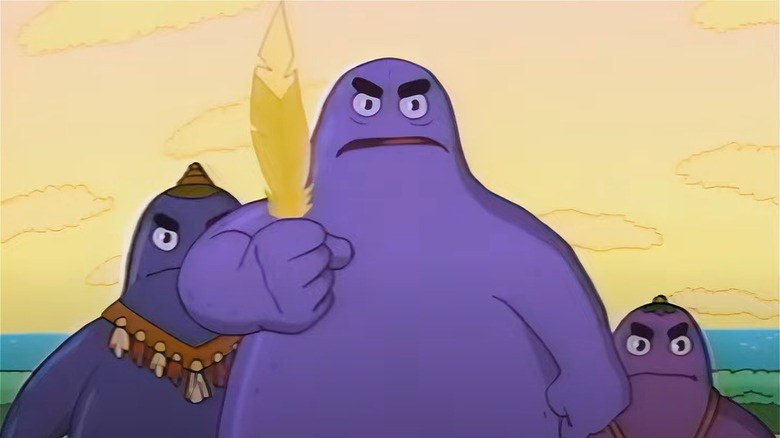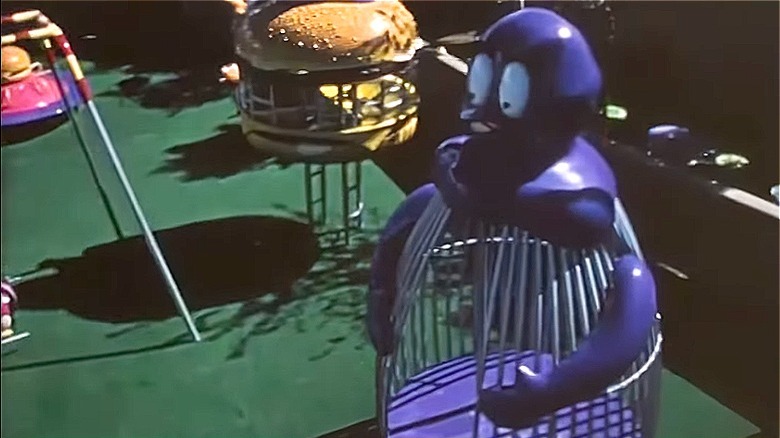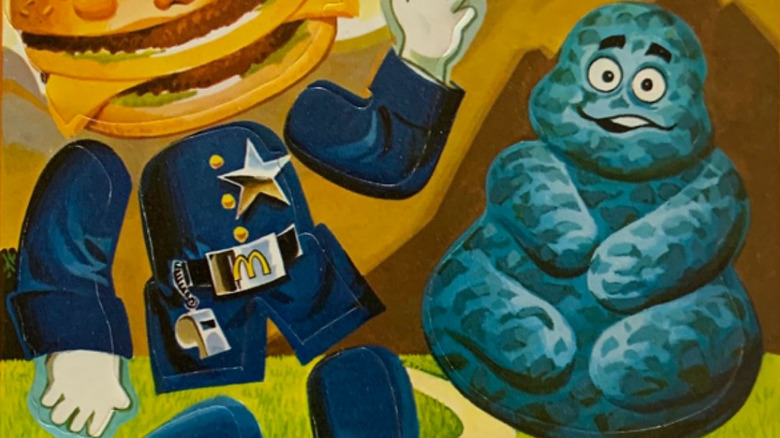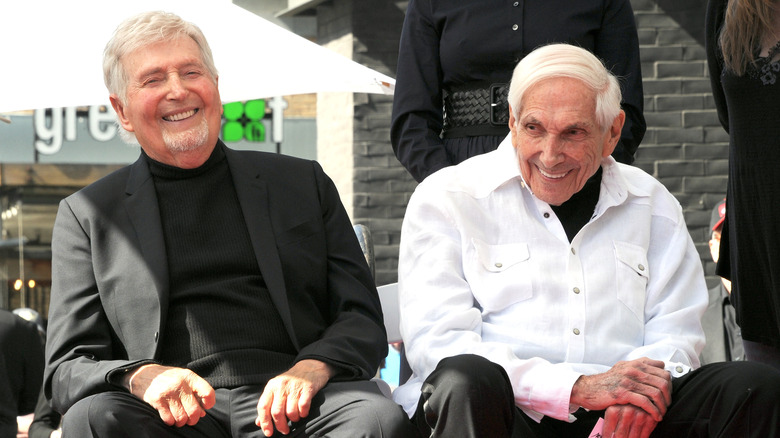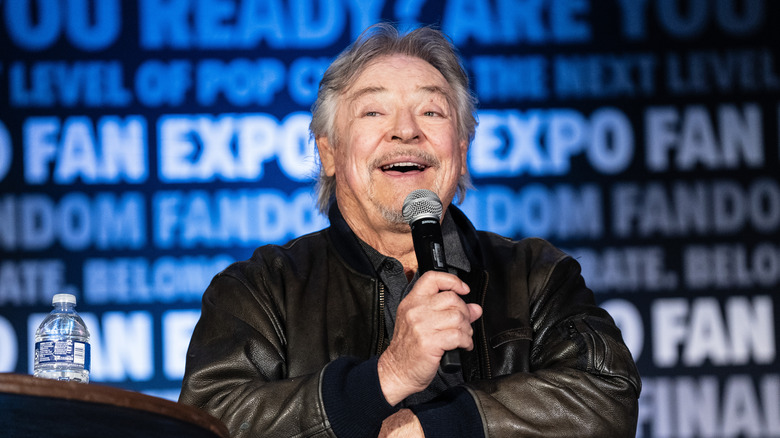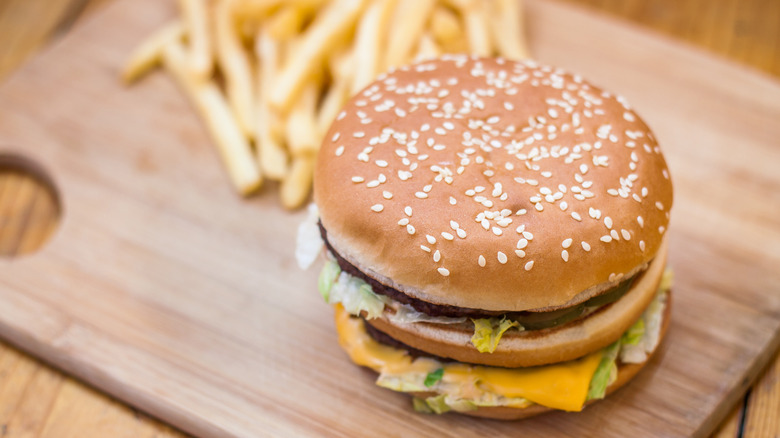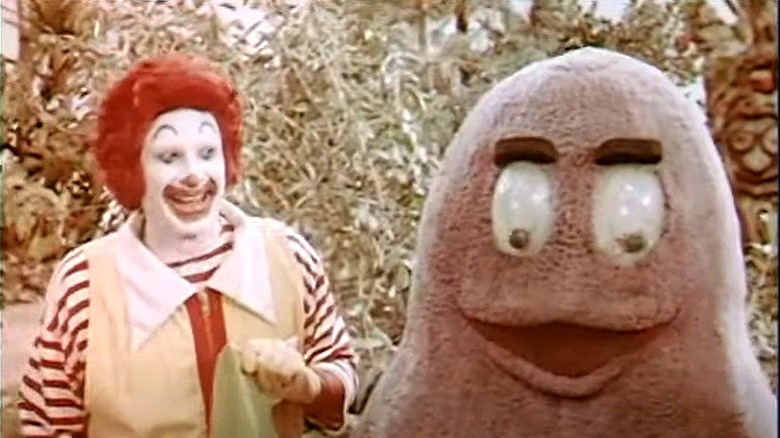The Untold Truth Of McDonald's Evil Grimace
While golden arches, Happy Meal boxes, or Big Macs might be among the first things that pop into your head when you think of fast-food chain McDonald's, food-loving mascots that inhabited a magical, made-for-TV landscape were a major part of the restaurant's history. And among all of them, the furry behemoth known as Evil Grimace was perhaps one of the most fascinating.
Lurking in the shadowy caves of McDonaldland, Evil Grimace was introduced as a violet-colored, four-limbed villain whose love for sweets seemed inversely proportional to his smarts. The character's turn as a fast food fiend was short-lived, though; nowadays, this foil-turned-friend simply goes by the more recognizable "Grimace," losing his extra arms and his "Evil" moniker while gaining a spot on Ronald McDonald's band of buddies.
Make no mistake, though, as the surprisingly deep well of Evil Grimace lore makes the character much more than a mere marketing misfire. In reality, the mascot's story is packed with more twists than a McFlurry, including previously unknown family members, vintage toys worth a king's ransom, and a lawsuit that came close to shutting down McDonald's entire mascot party for good. And of course, there's the enigma of what Evil Grimace was supposed to represent in the first place — a seemingly simple question that has proven to be surprisingly tough to answer.
Evil Grimace was part of an entire roster of wacky McDonald's mascots
Launched in the early 1970s, commercials set in the fantasy world of McDonaldland featured such colorful characters as the flagship character, Ronald McDonald, the dastardly, sandwich-stealing Hamburglar, and the breakfast-loving Birdy the Early Bird.
In his earliest appearance (the 1971 commercial "Evil Grimace and the Movie Director"), Evil Grimace's strange and unsettling qualities were already on full display. With multiple soft-drink cups stashed haphazardly in his two pairs of arms, the cross-eyed, purple-colored crook unnaturally bumbled and stumbled, oblivious to his surroundings. Ultimately, though, his nightmarish appearance and over-the-top antics fell flat with younger audiences, as he was deemed too creepy and disturbing for them. As former chief creative officer Ron Bergold recounted in an article for QSR Magazine (via Time): "The original Grimace was scaly, mean-looking, had four arms, and had no charm whatsoever. He scared kids." According to Bergold, Evil Grimace's lack of connection with consumers prompted McDonald's to completely rebrand the character: "We changed him to a soft, plush, two-armed blob of a sweetheart..."
Not all of the mascots received the same second chance that Evil Grimace got, though. Characters like Mayor McCheese, Officer Big Mac, the Fry Kids, and Captain Crook were among the McDonaldland denizens who were retired or simply faded into obscurity.
It only took two years for McDonald's to rebrand Evil Grimace
After his 1971 debut, Evil Grimace appeared at least two more times on TV before his reimagining: the 1972 commercial "Evil Grimace and the Beauty Contest" and the 1973 ad "Evil Grimace and the Shamrock Shake." By the time the blueberry-colored biped next showed up (in another TV ad launched in the same year), he was already sporting his updated look and a tweaked attitude.
While previous commercials showed Evil Grimace slinking away from the McDonaldland sun, the now-two-armed Grimace seemed to simply enjoy basking in the sunlight, even if it caused him to melt. He still retained his obsession with milkshakes — a fact highlighted by his audible fondness for the McDonald's Frosty Thick Shake — but at this point, he was no longer a thief. This personality adjustment likely helped solidify his place as one of Ronald McDonald's most loyal companions. For instance, in a 1977 commercial , we see the two colorful characters together on a snowy excursion, in a quest for delicious hot fudge, strawberry, and caramel sundaes.
When the Grimace Shake was announced on June 6, 2023, it was marketed as a celebration of Grimace's 52nd birthday. Since the count aligns with the year "Evil Grimace and the Movie Director" was released, this confirms that Grimace was indeed intended to be the same character as "Evil Grimace."
Grimace lost his 'Evil' moniker, but eventually gained a backstory
Given the fact that Evil Grimace (and later, Grimace) is essentially just a purple blob with arms and legs, it's easy to see him as just a minor character who doesn't require an extensive backstory to fulfill his purpose. With that said, McDonald's fans did eventually get a glimpse at the furry character's unexpectedly fleshed-out history — complete with quirky relatives and a secret origin — decades after his rebranding.
In a 1999 episode of the direct-to-video animated series "The Wacky Adventures of Ronald McDonald" titled "The Legend of Grimace Island," Grimace receives a letter summoning him to a mysterious location, taking him and his friends on a perilous journey filled with pirates, treasures, and sea monsters. The episode reveals that Grimace is actually part of an obscure tribe — an entire species of island-dwellers who look just like him, albeit in different shades of purple — and also introduces some of his relatives (including his Great Grandma Ginny Grimace, his Great Grandma Winky, and his brother, King Gonga). Subsequent PR materials mention the existence of his other relatives: his aunts Millie and Tillie, as well as his Uncle O'Grimacey (a name that longtime McDonald's enthusiasts would undoubtedly recognize).
Two Grimaces have been Shamrock Shake mascots
Years after McDonald's introduced its Shamrock Shake as a special season-specific offering for St. Patrick's Day, the fast food giant decided to promote it using one of their McDonaldland characters — and unsurprisingly, they opted to use the one who clearly had a sweet tooth. In what was likely his final TV ad appearance as "Evil" Grimace, the milkshake-loving mascot is seen turning from his usual purple hue to a vibrant green after imbibing one Shamrock Shake after another. However, he wouldn't be the only member of the Grimace species to promote the seasonal treat.
Enter Uncle O'Grimacey, a previously unknown relative of Grimace, who eventually became synonymous with the minty milkshake. Released in 1975, a St. Patrick's Day commercial served as Uncle O'Grimacey's grand induction into McDonald's lore. Clearly designed in the spirit of the celebration, Uncle O'Grimacey sported green fur and traditional Irish attire, including a green cob hat, vest, and shillelagh. For a time, Uncle O'Grimacey became a recurring character for Shamrock Shake promos, appearing in subsequent commercials that showcased his bubbly personality and unbridled enthusiasm for all things green (including, of course, the Shamrock Shake).
Sadly, Uncle O'Grimacey's time in the spotlight was short-lived. Per the records of Consumer Time Capsule, an account on X (formerly known as Twitter) operated by a self-described "Vintage McDonald's Super-Collector," the last appearance of Grimace's quirky uncle might have been on a McDonald's shake cup from 1980.
Evil Grimace was briefly a playground attraction
In 1972, McDonald's launched its McDonaldland line of playground attractions. Created for restaurant playgrounds by renowned design company Setmakers Inc., the McDonaldland lineup included an intriguing yet slightly eerie piece of equipment: the Evil Grimace Bounce & Bend. It featured an octopus-like rendition of Grimace with an extra pair of arms, clearly signaling that the design was intended to be the "Evil" version of the character.
An article in the bimonthly publication Illinois Parks & Recreation (via Northern Illinois University) shared specific details about the now-obscure playground attraction. The Evil Grimace Bounce & Bend's 10-foot-tall cage measured exactly 5'6" x 5'6", and was designed to hold between five and 10 children. The cage mechanism was made to sway back and forth as kids held on to its bars.
Though no longer mainstays in modern McDonald's playgrounds, relics of this bygone era can still be found on online auction sites. Judging from the fact that even partial pieces of the Bounce & Bend are being offered for over $2,000, it seems that collectors and enthusiasts still regard the Evil Grimace Bounce & Bend as a rare, nostalgic piece of McDonald's history.
Grimace: less of an 'evil' character, more of a slow-witted, mischievous goof
Even when he was still "Evil," Grimace was typically portrayed less as a sinister presence in McDonaldland and more as a clumsy, simple-minded source of comic relief. Looking back, it's evident that McDonald's leaned heavily into this aspect of the character when they rebranded him — and perhaps, this was precisely what made it easier to reimagine him in the first place.
In the McDonaldland Beauty Contest commercial, for instance, while Grimace is shown to have pilfered all the cups and shakes, he is ultimately depicted as a wide-eyed, gullible figure, suggesting that his actions are driven more by childish impulsiveness than malicious intent. On a similar note, in the Movie Director ad, Grimace's clumsiness and lack of coordination are on full display, on top of the fact that Ronald McDonald successfully tricks him. Even his green relative, Uncle O'Grimacey, celebrates St. Patrick's Day with festive cheer in various Shamrock Shake ads over the years, implying that villainy doesn't actually run in the Grimace family.
Finding vintage Evil Grimace merchandise is extremely rare
Vintage Evil Grimace merchandise can be hard to come by — the giveaway sign being the presence of an extra pair of arms on the rotund character — which isn't really surprising. After all, given McDonald's swift rebranding campaign, it makes sense that not a lot of collectibles from the early '70s would feature the "evil" version of Grimace. As the Grimace-themed online repository evilgrimace.com puts it: "Any McDonald's item depicting Grimace with 4 arms is definitely hard to find and very collectible."
One example of surviving Evil Grimace merchandise is a 1971 punch-out "Slaphappy" sticker sheet, which features the milkshake-loving thief sharing real estate with fellow McDonaldland character Big Mac. There's also a 1972 cookie box, priced at $170 in a sold eBay listing. Other notable pieces include a 1970 placemat which was sold for almost $30 and an unused Valentine's Day card from the 1970s that went for $7.50.
Was Evil Grimace nothing more than a copycat mascot?
At the height of its McDonaldland campaign, McDonald's found itself entangled in a fierce legal battle. Allegations of character plagiarism from the creators of a popular children's television show cast a shadow over the denizens of McDonaldland. Incidentally, this may have also contributed to the company's decision to rebrand Evil Grimace.
Per a court document from 1977, siblings Sid and Marty Krofft (pictured), co-creators of the puppet program "H.R. Pufnstuf," were reportedly approached by ad agency representatives on behalf of McDonald's for a potential marketing collaboration. According to the Krofft brothers, the initial pitch involved a McDonald's campaign featuring some of the "H.R. Pufnstuf" puppets, in exchange for payment to the Kroffts for "preparing artistic designs and engineering plans." Shortly after, the Kroffts were informed that McDonald's was no longer moving forward with the ad agency on the proposed campaign, which turned out to be false. The resulting McDonaldland commercials even featured characters that allegedly bore strong resemblances to certain "H.R. Pufnstuf" characters, such as Mayor McCheese, who was seen as a ripoff of the puppet show's titular character.
While not directly mentioned in the case records, McDonaldland's Evil Grimace did seem to share some key traits with a different "H.R. Pufnstuf" puppet, Seymour Spider (as pointed out many years later by users on social media). Both characters were villainous, fluffy, roly-poly, and brightly colored; in addition, they both had extra arms.
Evil Grimace was portrayed by three voice actors
Despite his short-lived presence in McDonaldland, Evil Grimace's portrayal on screen involved the talents of not one, not two, but three actors — an interesting feat, considering that the character didn't even have that many appearances or lines to begin with.
Patti Saunders and Frank Welker (pictured) initially portrayed Evil Grimace in his debut appearance in 1971, with the former wearing the suit and the latter providing the character's voice. After that, veteran actor and writer Lennie Weinrib took over voicing duties for Evil Grimace's second commercial the following year. And for Evil Grimace's third and final "McDonaldland" TV ad in 1973, Welker reprised the role.
Aside from her work as part of the "McDonaldland" campaign, Saunders also lent her acting talents to programs like "The Big Circus" and "Peter Gunn." As for Weinrib, he had an extensive acting, directing, and writing career spanning almost four decades, working in both animation and live-action productions. Similarly, Welker has an extensive list of credits in animation, film, and television, voicing iconic characters such as Fred Jones in "Scooby-Doo" and Megatron in "Transformers." As of 2023, he has remained active in the industry, with roles on "Futurama" and "Teen Titans Go!" as well as the video game "Nickelodeon All-Star Brawl 2."
Evil Grimace left most of the McDonald's menu alone
Throughout Evil Grimace's appearances in McDonald's commercials, it was evident that his culinary interests were limited to just drinks and desserts, with little regard for any of the solid food or meal offerings on the fast food chain's menu. Unsurprisingly, this key trait of the character would survive his transition into "just" Grimace.
For instance, the McDonaldland Beauty Contest commercial shows us that, after shortsightedly stealing all the beverage cups in McDonaldland, the purple behemoth was baffled and distressed by the fact that they contained neither Coca-Cola nor milkshakes. Similarly, the "Movie Director" commercial emphasizes Evil Grimace's singular fixation on sugary beverages. In the ad, he gleefully swipes shakes and Cokes, completely ignoring any mention of burgers and fries, which are the brand's signature items. And in his final appearance as Evil Grimace in the Shamrock Shake commercial, the four-armed, milkshake-misappropriating menace happily chugs down all the Shamrock Shakes in his arms to the point where he turns green, selfishly choosing to polish them all off instead of sharing them with the kids who approach him.
With that said, none of this is particularly shocking; after all, there were other characters in the McDonaldland mascot roster who were more than happy to take whatever Evil Grimace wasn't interested in, like Hamburglar (who was obsessed with burgers) and Captain Crook (who fawned over the Filet-O-Fish).
What was Evil Grimace supposed to be, exactly? Not even McDonald's knows
Whether the subject in question is Grimace or Evil Grimace, there's one persistent, burning question on every McDonaldland fan's mind: What, exactly, is Grimace supposed to be? As it turns out, even the company that he represents isn't sure.
There are at least two theories regarding the truth about Evil Grimace's nature. In a 2021 interview with CBC, Brian Bates, a manager of a McDonald's franchise in Canada, shared his take: Grimace, evil or not, is "an enormous taste bud, but a taste bud nonetheless." Based on Bates' response, it can be inferred that the purple character exists simply as a reminder that "the [McDonald's] food tastes good." On the other hand, a 2012 tweet from McDonald's Corporation disputes this idea, calling the mascot "the embodiment of a milkshake" while acknowledging the existence (and implied inaccuracy) of the "Grimace is a taste bud" idea.
In recent times, however, the company seems to have taken a more ambiguous stand on the purple pilferer's phylogeny, as evidenced in McDonald's cryptic press release for Grimace's 52nd birthday celebration: "Our timeless bestie has become a fan-favorite known for his signature fuzzy purple look, friendly and playful personality, love for shakes, and of course – ambiguous nature. What exactly is Grimace? Perhaps we'll never know..."
